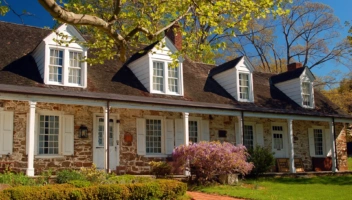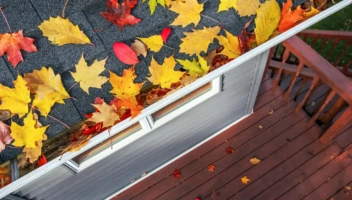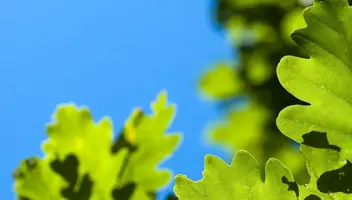The Worst Trees to Plant Near Your Home
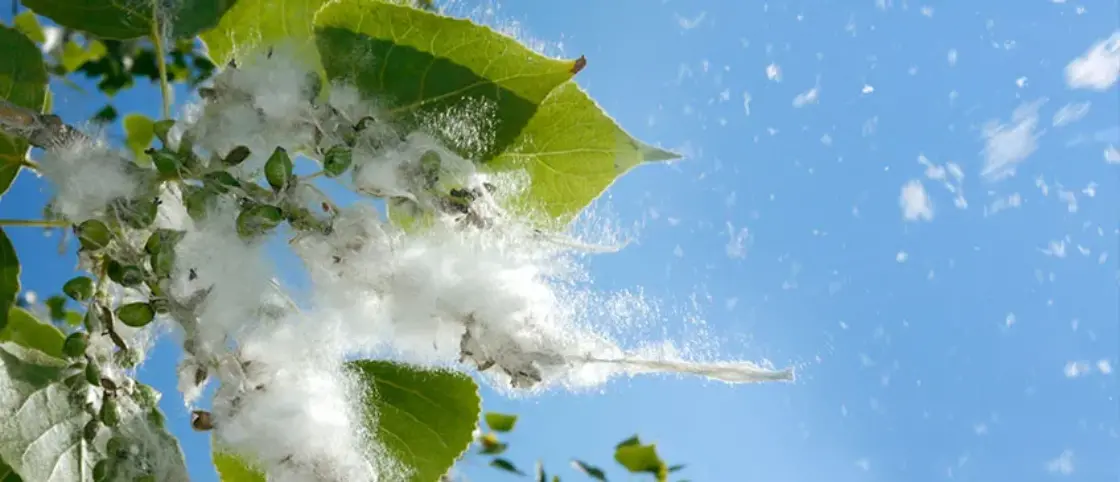
Trees indeed offer lots of different benefits. Their beauty provides shade and comfort and can improve your surroundings by reducing pollution, lowering energy costs, and improving the appearance of your neighborhood.
However, damage from broken limbs or twigs, invasive root systems, and leaf/fruit/flower debris can be bad news for your gutter system, and some tree varieties aren’t ideal to plant around your property.
The worst tree types to plant near your home will vary by region across the U.S. For instance, the Bradford pear is a common pest in the Southeast, while cottonwoods are a gutter-clogging issue for the Midwest.
No matter where you live, there is a tree that can be detrimental to your gutter system’s health.
In this article:
- Why Tree Choice Matters for Gutter Health
- The 11 Worst Trees For Your Home
- Seasonal Debris & Maintenance Calendar
- Protecting Your Home From Tree Debris
- Frequently Asked Questions
Why Tree Choice Matters for Gutter Health
Although trees can make your yard beautiful, they can be dangerous for your gutters.
Leaves, seeds, pods, and fluff are all common culprits left behind by a variety of trees. When these pieces of tree debris collect in your gutters, they can cause clogs and potentially lead to system overflow, which can create water damage to the home and foundation.
If you live in the South, you may have sweetgum trees that drop prickly fruit known as gumballs. These jam up gutter systems if they are not properly disposed of. The same is true of fluffy cottonwood seeds that clutter gutters in the Midwest. Every region has its own worst trees for gutter health.
Some trees are worse debris offenders than others, but many of the debris issues can be avoided with a solution like LeafFilter gutter guards. With their surgical-grade stainless steel micromesh technology, only water passes through them into the gutter. This helps reduce the need for cleaning your gutters and stops common debris in its tracks.
Please note: Always check for necessary planting conditions and native planting guides before planting new trees, as not all recommendations are ideal for all regions/environments.
The 11 Worst Trees For Your Home
1. White Mulberry
White mulberry trees are weedy, invasive, extremely messy, and prone to insect infestations. Their aggressive surface roots can cause your pavement to crack. And, their prodigious amounts of pollen can cause annoying allergies for you and your family. The mulberry tree provides shade that is so dense that grass is unable to grow underneath.
These trees, common to the Midwest, also drop mulberries, which can easily clog gutters and stain them and other home surfaces. To help avoid these issues, it’s best to plant these trees 20 to 30 feet away from your home, plumbing lines, and driveway.
Suggested planting alternatives: Male, fruitless mulberry trees: Stribling, Kingan, and Urban
2. Hackberry
The hackberry tree is a weedy, messy tree that you’ll want to refrain from planting in your yard. This tree has aggressive root systems that can cause driveway and home foundation damage if planted too close to either. You’ll recognize the hackberry from a distance by its light gray, warty bark on massive trunks. It grows at a rapid pace, reaching 80 feet tall by 60 feet wide. Small, bluish-black fruits spread seedlings all over, which will attract birds from all over.
Hackberry trees, common on the East Coast, the Midwest, and the Great Plains, are particularly known for developing sooty mold, a black powdery fungus that grows on the tree. These plants (and anything around them) become sticky due to the excretion of the bugs that love to eat the plant sap.
Between the fruit, leaf debris, pests, and birds, there is a lot that can clog a gutter system.
Suggested planting alternatives: Spicebush, Redbud, or fruitless Serviceberry varieties
3. Cottonwood
Cottonwood trees are massive shade trees that can be found all throughout the United States. You’ll recognize this tree by its broad, white trunks. Their bright green foliage happens to turn brilliant yellow in the fall, so although they are aesthetically pleasing, the cottonwood tree can cause many different problems.
First, the cottonwood has a very shallow and soft root system, making it prone to rotting and very unstable during severe storms. A big gust of wind could send this tree to the ground.
Second, aside from the fact that this tree is very brittle, it can also be plagued by insects and diseases, making it more vulnerable to damage. The last thing you want to experience is a cottonwood tree falling on your roof or car after a big storm!
Additionally, the fluffy seeds can quickly accumulate in the gutters, causing clogs and overflow issues.
Suggested planting alternatives: Fruitless Serviceberry, male non-seeding Cottonwoods
4. Bradford Pear
Many homeowners regard the Bradford pear as an exotic plant, and they are right to some extent. A little over a century ago, the Bradford pear was imported into the U.S., becoming pretty popular right away, to the point that it is now considered highly invasive across the country. Planting them is currently banned in Ohio, Pennsylvania, and South Carolina.
However, the Bradford pear is known for its tuna-scented flowers and for dropping debris that can clog your gutters. In addition to exuding a very pungent odor, this tree is incredibly fragile, causing a lot of broken limbs and snapping in half during storms.
For these reasons, you’ll want to steer clear of planting the Bradford pear tree in your backyard.
Suggested planting alternatives: Red Buckeye and fruitless Serviceberry
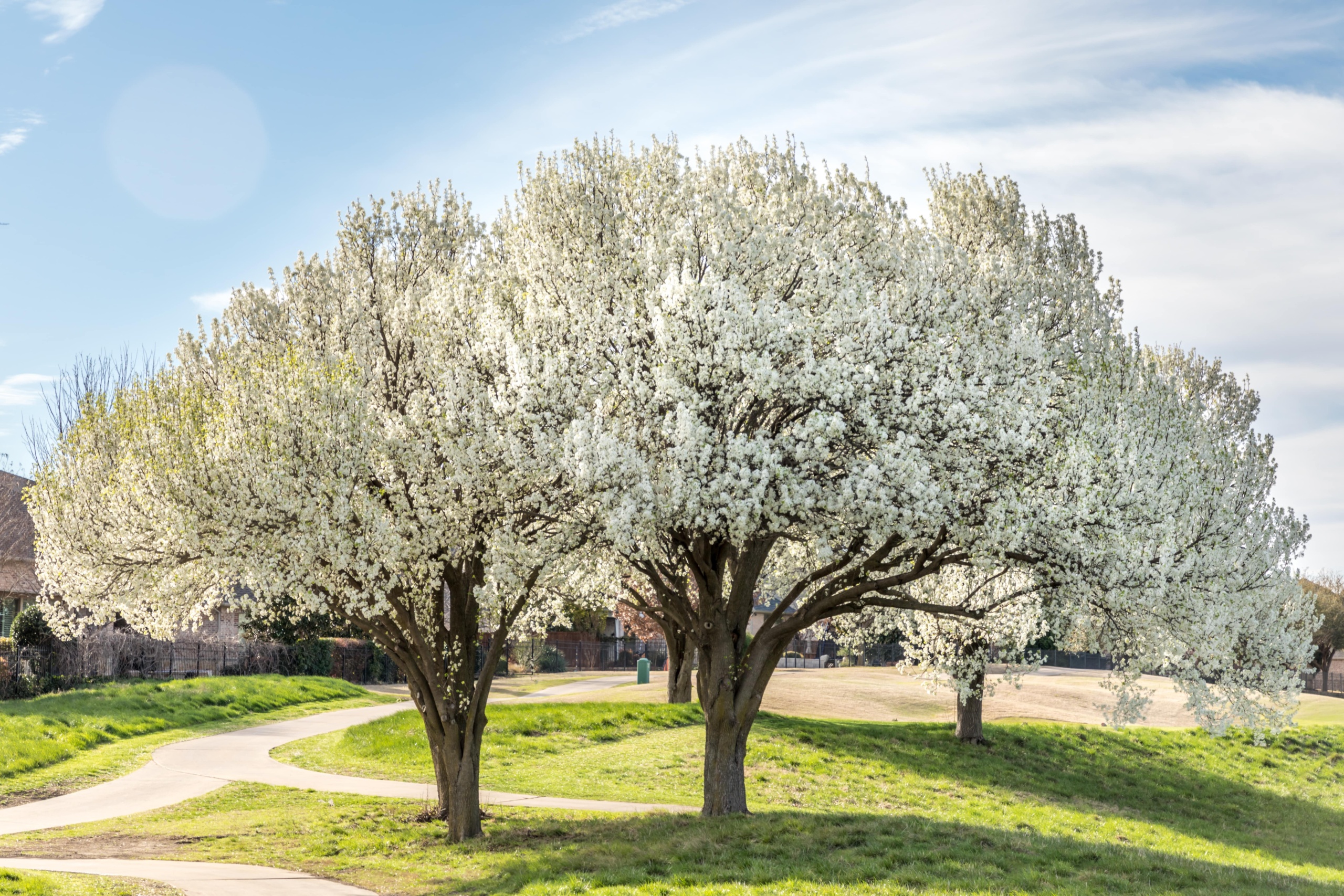
5. Mimosa Tree
Like the Bradford pear and the cottonwood, the mimosa tree is also known to be extremely fragile. In addition to not being a sturdy tree, the mimosa tree attracts webworms.
You’ll recognize the mimosa tree by its fluffy pink flowers, which open in the early summer. However, as pretty as the flowers are, they only last two weeks. Then, they are replaced by a lot of large, ugly seed pods that can germinate an entire neighborhood very quickly, making it a highly invasive pest tree across the United States.
Suggested planting alternatives: Fringetree, River Birch, and Flowering Dogwood
6. Weeping Willow
The weeping willow is easy to pick out from a crowd of trees across the country. Its long, slender branches dip towards the ground, making it look as if it is crying. It is a beautiful tree that many homeowners like in their backyard; however, the weeping willow can cause many problems.
First, the weeping willow requires a lot of water. Its roots will suck out almost all of the water from the soil, which can end up harming any plants that grow around it. They also shed a significant amount of leaves and twigs year-round rather than seasonally, causing gutter clogs.
Additionally, these massive trees can grow to 75 to 100 feet, but are relatively weak-wooded. If a storm or wind damages it, the tree can cause major damage to your garage, gutters, roof, or car.
Suggested planting alternatives: Swamp White Oak and Sweetbay Magnolia
7. Ash Trees
Most commonly found in the Midwest and Eastern regions of the country, ash trees can be a hazard to gutters, mostly due to their leaf drop and seed pods. These pods are known as samaras but are commonly referred to as “helicopters” because they fall in a circular motion, like a helicopter blade.
Ash trees can also create significant bark debris if they become too dry or become infected with Emerald Ash Borers (an invasive beetle), since woodpeckers will shred the bark while hunting for them.
Due to these issues, it’s best to plant these trees at least 20 feet away from the home to avoid gutter clogs.
Suggested planting alternatives: Swamp White Oak and American Hophornbeam
8. Lombardy Poplar
Like many of the other trees we’ve mentioned so far, Lombardy poplars do drop large leaves in the fall. However, they also drop fibrous catkins (which appear like miniature cattails) full of cottony seeds in the spring, making them even more tricky for gutter health. You may need to clean out your gutters twice as often, as these trees create more debris.
More than that, Lombardy poplars also have aggressive root systems that can spread up to over 50 feet beyond the tree canopy. Because of this, you’ll want to plant them at least that far away from structures to protect against damage.
Suggested planting alternatives: American Hornbeam
9. Silver and Norway Maple
Similar to ash trees, silver and Norway maples also drop a significant number of samaras or maple spinners in the spring and early summer, which clog gutters.
They also have large, shallow root systems that can damage nearby structures and pavement. These shallow roots can cause root heaving, which can lift sewer lines, sidewalks, driveways, and building foundations.
Suggested planting alternatives: Fringetree and Eastern Redbud
10. Tree of Heaven
Sometimes called gutter palms, tree of heaven plants are a noxious invasive species that reproduces quickly and aggressively. These trees are known to grow anywhere, from cracks in sidewalks to rooftops and gutters, which can result in expensive repairs and damage.
They have an extensive, fast-growing root system that can also damage foundations, pavement, and even sewers. It also serves as a home to the highly destructive and invasive Spotted Lanternfly.
Suggested planting alternatives: Fringetree
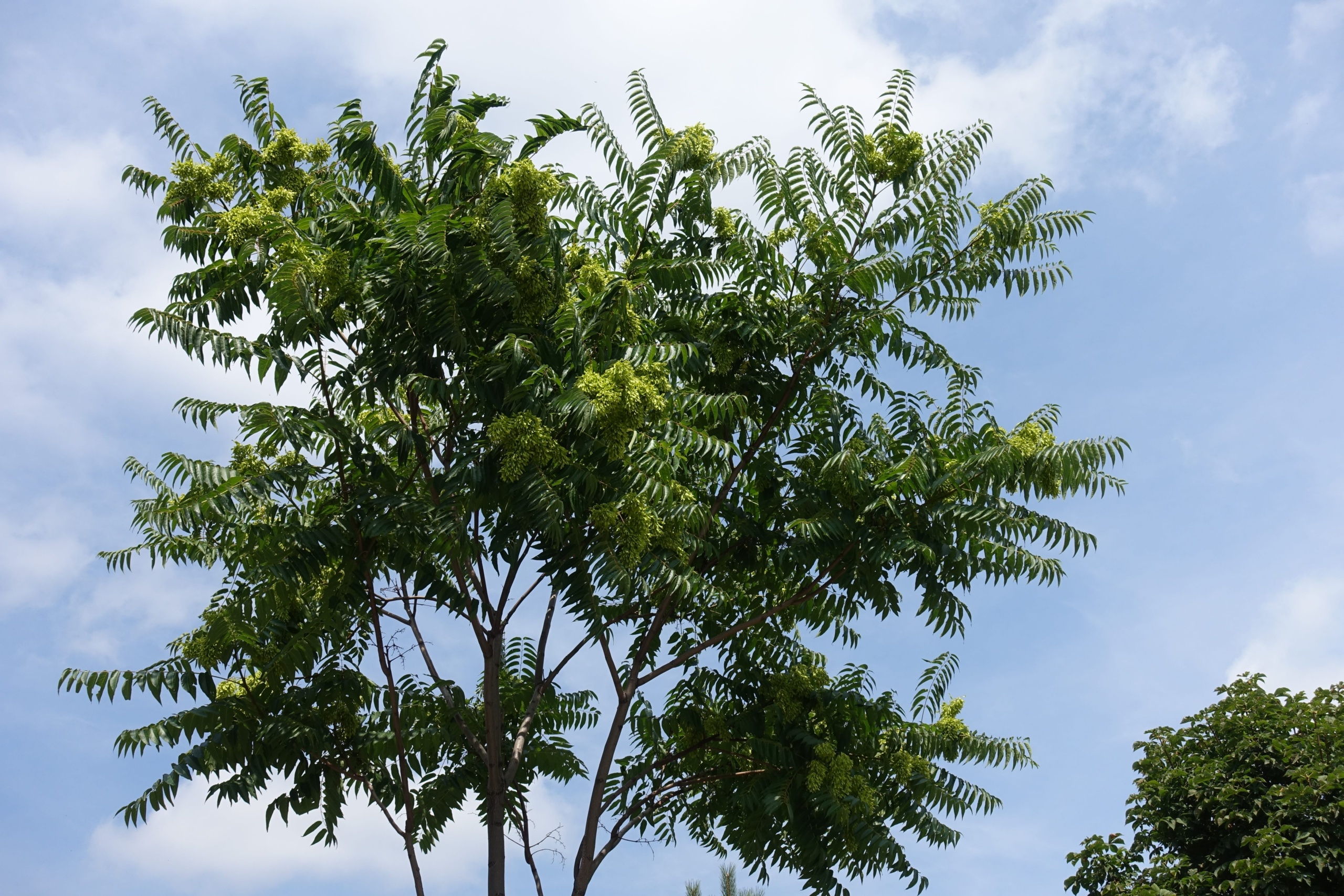
11. Sweetgum
Just like weeping willows, sweetgum trees also create debris pretty constantly. They shed their leaves in the fall, but all drop their spiky gumball fruits in the fall, winter, and sometimes into the spring. All of that debris gets easily stuck in a gutter system, potentially creating clogs or backups for a majority of the year.
They are also known for dropping their limbs in the summer if they dry out too much, which can cause structural damage if the branches hit a building.
Suggested planting alternatives: Eastern Redbud
Seasonal Debris & Maintenance Calendar
All of these trees have different maintenance cycles that vary based on where you live. However, if you have these common problem trees in your yard, it is crucial to keep them maintained to avoid damage to your home’s gutters, foundation, and exterior structure.
| Tree Type | Peak Shedding | Debris Type | Gutter Impact | Region(s) | Recommended Cleaning Frequency |
|---|---|---|---|---|---|
| White Mulberry | Late Spring–Summer | Dense leaves, pollen, fruit | Fruit mats and pollen cakes onto mesh; leaves form heavy blockages | Northeast, Mid-Atlantic, Southeast, Southwest | Every 2–3 months; monthly in humid climates |
| Hackberry | Summer–Fall | Berries, leaves, sticky honeydew from insect waste | Sticky residue creates mold/sludge inside gutters; berries block downspouts | Southeast, Midwest, Mountain West | Every 2–3 months |
| Cottonwood | Late Spring | Cottony seed fluff, brittle twigs | Fluff blankets gutter surfaces and clogs mesh; twigs accumulate in troughs | Midwest, Mountain West, Pacific Northwest | Every 2 months during peak; quarterly otherwise |
| Bradford Pear | Early Spring & Fall | Flowers, leaves, brittle limbs | Flower litter mats onto gutters; limbs snap and block drainage | Southeast, Northeast & Mid-Atlantic | Quarterly; pre-storm inspections recommended |
| Mimosa Tree | Summer | Seed pods, flowers, webworm debris | Pods pile up; pest debris creates sticky buildup on guards | Southeast, Southwest | Every 2–3 months |
| Weeping Willow | Spring–Fall | Fine leaves, thin twigs | Fine debris compacts and traps moisture; heavy load in wet regions | Pacific Northwest, Mountain West | Every 2–3 months; monthly near water |
| Ash Trees | Spring | Samaras (helicopters), bark flakes | Samaras wedge under guards; bark debris forms sludge | Northeast, Midwest | Every 2–3 months; more if EAB-damaged |
| Lombardy Poplar | Spring–Fall | Large leaves, catkins, sucker debris | Catkins clog gutters; leaves layer heavily; sucker debris piles up | Mountain West, Southwest | Quarterly; post-storm checks |
| Silver & Norway Maple | Late Spring (samaras) & Fall (leaves) | Samaras, dense wet leaves | Samaras jam under screens; leaves mat heavily in rainy climates | Northeast, Midwest, Pacific Northwest | Every 2 months during samara season; 3–4×/year in PNW |
| Tree of Heaven | Spring–Summer | Heavy seed clusters, brittle branches | Seeds and new growth overwhelm gutters; limbs break and obstruct water flow | Southeast, Midwest, Southwest | Every 3 months |
| Sweetgum | Late Fall–Winter | Spiky gum balls, leaves | Gumballs block downspouts and dent guards; leaves add volume | Southeast, Northeast, Pacific Northwest | Quarterly; late-fall deep clean |
Protecting Your Home From Tree Debris
When planting trees, it’s pivotal to know which ones are the most likely to cause you issues in the future. We recommend consulting with a local arborist for tips on which trees to plant, future removal, and annual tree care.
From the spiky gumballs from a sweetgum tree to the constant debris falling from a weeping willow, there are considerations to be made. Not only are these considerations important to protect your home itself, but also your gutter system, because debris falling into the gutters and clogging them is highly likely.
If you already have any of these trees in your yard, you should be diligent about watching for gutter, home, and even tree damage. Inspecting and cleaning out your gutters should be a bi-annual priority unless you have trees that create a lot of debris.
In that case, try cleaning the system more often to prevent overflow, backups, and damage. Installing a gutter guard from LeafFilter can also be your first line of defense against debris. The guard goes over the gutter, installed at an angle that allows it to shed debris while accepting water.
When you are ready to implement these protective guards, contact us for a free estimate.
Frequently Asked Questions
Which trees cause the most gutter clogs?
Several types of tree species cause gutter clogs, including sweetgum trees, which drop spiky gumballs, and cottonwood trees, which drop fibrous seedlings. Other trees, like weeping willows, are an issue because they’re constantly losing twigs and leaves, and Lombardy poplars drop catkins, which are fluffy seedpods similar to cattails you’d see in a swamp.
How far should I plant trees from my house?
Regardless of how much debris a tree sheds, it’s a good idea to plant it at least 10 feet away from the home to avoid root spread and foundational or pavement damage. However, for very large trees, you may need to plant at least 50 feet away to reduce the risk of branch loss, damage to the home, and root spread issues.
Can I protect my gutters if I already have one of these trees?
You can! In addition to being diligent in gutter cleaning and maintenance, the easiest way to protect the system is to have LeafFilter gutter guards professionally installed. These micromesh filter guards will help protect the gutter from falling debris while allowing water to flow through. This helps remove the threat of clogs and overflow altogether.
What trees are best near gutters?
The best trees to plant near gutters are slow-growing trees with non-aggressive roots and trees with minimal fruit or leaf droppings. These are the least likely to cause issues, but could still create clogs if the gutters are not maintained. A few less debris-laden trees include Eastern Redbud and the American Hornbeam.
How often should I clean gutters with heavy leaf-shedding trees?
It depends on how often the trees are shedding. If they are constantly shedding, you may need to check the gutters at least monthly for clogs. If they shed once per season or twice per year, prioritize cleaning out your gutters around those times of year. The general rule of thumb for cleaning out gutters overall is two times per year, once in the spring and once in the fall.
